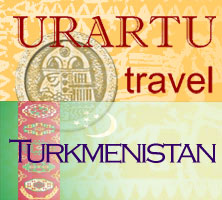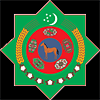About Turkmenistan
General Information -- Geography -- Climate -- Religion -- Language -- Population and Ethnic Composition-- Government -- Administrative Division -- Time Zone -- Currency Exchange and Credit Cards -- Capital City -- Official Holidays -- Airports and Public Transportation -- Traditional Cuisine -- Brief History
General Information
Turkmenistan is a country in Central Asia. The name Turkmenistan is derived from Persian, meaning "land of the Turkmen". Before 1991, it was a constituent republic of the Soviet Union, called the Turkmen Soviet Socialist Republic.
Geography
The country is approximately 488,100 square kilometers (188,457sqmi). It is bordered by Afghanistan to the southeast, Iran to the southwest, Uzbekistan to the northeast, Kazakhstan to the northwest, and the Caspian Sea to the west. 90% of the country is covered by the Karakum Desert. The center of country is dominated by Turan Depression and the Karakum Desert which are mostly flatlands. The Kopet Dag Range, along the southwestern border, reaches 2,912 meters (9,553ft). The Turkmen Balkan Mountains in the far west and the Kugitang Range in the far east are the only other appreciable elevations. Rivers include the Amu Darya, Murgap, and the Hari Rud.
Climate
The climate is subtropical desert, with little rainfall. Winters are mild and dry, with most precipitation falling between January and May. Heaviest precipitation is in the Kopetdag Range.
Religion
Muslim 89%, Eastern Orthodox 9%, unknown 2%
Language
Turkmen is the official language of Turkmenistan, though Russian still is widely spoken as a "language of inter-ethnic communication" (per the 1992 Constitution). It is spoken by approximately 3,430,000 people in Turkmenistan, and by an additional approximately 3,000,000 people in other countries, including Iran (2,000,000), Afghanistan (500,000), and Turkey (1,000).
Population and Ethnic Composition
The majority of Turkmenistan's citizens are ethnic Turkmen; other ethnic groups include Russians, Ukrainians, Uzbeks, Azeris, Armenians, Tatars, and the Baloch.
Government
Turkmenistan is a republic with authoritarian presidential rule. The present president was unanimously approved as president for life by the Assembly on 28 December 1999. He appoints the deputy chairmen of the cabinet of ministers. The legislature, the Assembly (Mejlis) has 50 members, elected for a five year term in single seat constituencies. Turkmenistan is a single-party state, the only political party; the Democratic Party of Turkmenistan is legally allowed to hold power. All candidates at the elections belonged to this party. Furthermore, the Khalk Maslakhaty (People's Council) which is considered the ultimate representative body, has 65 members. All candidates at the elections of 7 april 2003 (turnout 89.3 %) belonged also to the DPT. The Assembly is an example of a "Rubber Stamp Legislature"
Administrative Division
Turkmenistan is divided into 5 provinces or welayatlar and one independent city: Ashgabat.
Time Zone
Turkmenistan Standard Time is 5 hours ahead of Greenwich Mean Time (GMT+5).
Turkmenistan does not operate Daylight-Saving Time
Currency Exchange and Credit Cards
1 Manat (TMM) = 100 tenge. Notes are in denominations of TMM10,000, 5000, 1000, 500, 100, 50, 10, 5 and 1. Coins are in denominations of 50, 20, 10, 5 and 1 tenge.
Credit cards are generally not accepted.
Capital City
Ashgabat, is the capital city of Turkmenistan, a former Soviet republic. Ashgabat has a population of 695,300 (2001 census estimate) and is situated between the Kara Kum desert and the Kopet Dag mountain range. The name is believed to derive from the Persian Ashk-abad meaning "the City of Arsaces". Ashgabat has a primarily Turkmen population, with minorities of ethnic Russians, Armenians, and Azeris.
Museums include the Turkmen Fine Arts Museum, noted for its impressive collection of woven carpets, and the Turkmen History Museum which has artifacts dating back to the Parthian civilisation. The Academy of Sciences of Turkmenistan is an important institute of higher learning. Large mosques include the Azadi Mosque, the Khezrety Omar Mosque, and the futuristic Iranian Mosque. Ashgabad is also home to the Arch of Neutrality, which is a large tripod, upon which a golden statue of Turkmen President Saparmurat Niyazov. This statue rotates in order to always face the sun during daylight hours. It is said to be made of pure gold.
Official Holidays
- January 1 - New Year's Day
- January 12 - Remembrance Day
- January 21 - Kurban Bairam (Feast of the Sacrifice)
- February 18 - President's Birthday
- February 19 - National Flag Day
- March 8 - International Women's Day
- Mar 20 - Novruz Bairam (Turkmen New Year)
- May 9 - Victory Day
- May 18 - Constitution Day
- June 21 - Day of Election of First President
- October 6 - Remembrance Day (Anniversary of the 1948 Earthquake)
- October 28 - Independence Day
- November 3-5 - Ramadan Bairam (End of Ramadan)
- December 12 - Neutrality Day
Airports and Public Transportation
Ashgabat Airport (ASB) is approximately 13km (8 miles) northwest of the city centre. The airport is served by buses and taxis. There are international connections by Turkmenistan Airlines to Abu Dhabi, Birmingham, Damascus, Delhi, Istanbul, Karachi, Kyiv, London and Moscow. Ashgabat is also served by Asseman Airlines from Tehran, by Lufthansa from Frankfurt/M and by Turkish Airlines from Istanbul. There are also connections within the CIS.
Traditional Cuisine
Turkmenian dishes are mostly meat dishes. In different regions of the republic meat of different animals such as sheep, camel, mountain goat, quail and pheasant is used. Beef is not a traditional meat that Turkmenian people eat. Cooking practices are also diverse: meat can be fried in its own juice or being skewered it can be roasted over the red-hot coals; sometimes it is baked in tandyr - clay oven. Turkoman people used to preserve meat in an unusual way, garin. Small slices of meat or fat are laid tightly into a sheep's or goat's stomach rubbed with salt and capsicum. The stomach then is dug into hot sand for a day. Late in the evening it is dug out from the sand and tied up to a high stick so as a night wind could blow it from all sides. The procedure is repeated several times. Meat, dried this way, has a special taste and can be kept for a long time.
Turkmenian soup, gaynatma, is cooked from young camel meat. To give it more piquancy, garlic, saffron, mint, capsicum are added alongside with onion and pot-herbs. The same recipe is used in cooking of dograma soup, but instead of camel meat mutton is used and berries of sour plum are added into the dish during cooking. The soup is served with the dry-bread, patyr, crumbled into it.
Pilav, favorite dish in all Central Asian countries, has its own peculiarities in Turkmenistan. For Turkmenian ash, as pilav is named here, the meat of game birds, for instance pheasant, is used instead of traditional in Central Asia mutton or lamb. Turkmenian ash is made of green rice; carrots are partially or completely substituted for apricot, whereas sheep's fat is substituted for sesame oil. The dish is served with sauce made of sour plum tkemali, and pomegranate juice.
Brief History
The territory of Turkmenistan has a long and checkered history, as armies from one empire to another decamped on their way to more prosperous territories.
Alexander the Great conquered the territory in the 4th century B.C. on his way to India. One hundred and fifty years later Persia's Parthian Kingdom established its capital in Nisa, an area now located in the suburbs of the modern-day capital of Ashgabat. In the 7th century A.D. Arabs conquered this region, bringing with them Islam and incorporating the Turkmen into Middle Eastern culture. It was around this time that the famous Silk Road was established as a major trading route between Asia and Europe. The Turkmenistan region soon came to be known as the capital of Greater Khorasan when the caliph Al-Ma'mun moved his capital to Merv.
In the middle of the 11th century, the powerful Turks of the Seljuk Empire concentrated their strength in the territory of Turkmenistan in an attempt to expand into Afghanistan. The empire broke down in the second half of the 12th century, and the Turkmen lost their independence when Genghis Khan took control of the eastern Caspian Sea region on his march west. For the next seven centuries, the Turkmen people lived under various empires and fought constant intertribal wars. Little is documented of Turkmen history prior to Russian engagement, however from the 13th through 16th centuries, Turkmen formed a distinct entholinguistic group. As the Turkmen migrated from the area around the Mangishlak peninsula in contemporary Kazakhstan toward the Iranian border region and Amu Darya river basin, tribal Turkmen society further developed cultural traditions that would become the foundation of Turkmen national consciousness.
Between the 17th and 19th centuries control of Turkmenistan was fought over by Persian shahs, Khivan khans, the emirs of Bukhara, and the rulers of Afghanistan. By this time, the region of Turkmenistan as well of the rest of the area inbetween the Persian-Afghan-Indian and Russian borders was unmapped and virtually unknown to Europe and the Western world. Rivalry for control of the area between the British Empire and Tsarist Russia led to the establishment of The Great Game. Throughout their conquest of Central Asia, the Russians were met with the stiffest resistance by the Turkmen. By 1894, however Russia had gained control of Turkmenistan and incorporated it into its empire. The rivalry officially concluded with the Anglo-Russian Convention of 1907. Slowly, Russian and European culture were introduced to the area. This was evident in the architecture of the newly-formed city of Aşgabat which was to be the country's capital. By the October Revolution of 1917 in Russia and subsequent political unrest led to the declaration of the Turkmen Republic as one of the 15 republics of the Soviet Union in 1924. At this time the modern borders of Turkmenistan were formed.
As a Soviet republic, Turkmenistan went through a process of further Europeanisation. The tribal Turkmen people were encouraged to become secular and adopt western-style clothing. The Turkmen alphabet was changed from the traditional Arabic script to Latin and finally to Cyrillic. However, bringing the Turkmens to abandon their previous nomadic ways in favor of communism was not fully embraced until as late as 1948. Nationalist organizations in the region also existed during the 1920s and the 1930s.
When the Soviet Union began to collapse, Turkmenistan and the rest of the Central Asian states heavily favored maintaining a reformed version of the state, mainly because they needed the economic power and common markets of the Soviet Union to prosper. However, in 1991 the Soviet Union split and Turkmenistan was one of the last countries to declare its independence. The former Soviet leader, Saparmurat Niyazov, remains in power to this day. His policies have changed greatly since Soviet times: He is friendly to foreign corporations, he has rather tense relations with Moscow and he styles himself a promoter of traditional, Muslim, Turkmen culture. One thing that has not changed, however, is the extent of his power which seems to have been greatly enhanced since the early 1990s.
Today, Niyazov is one of the world's most brutal and authoritarian dictators. He calls himself "Turkmenbashi," a title which means "leader of all ethnic Turkmen" in a similar style to Mustafa Kemal Atatürk. He has become notorious in the Western world for his cult of personality and the repressive measures he takes to crush political dissent. Although Turkmenistan has lots of natural resources, for which the country's economy could potentially benefit, all of the revenue that comes from foreign investment of these resources is wasted by Niyazov for grandiose schemes such as erecting solid gold statues of himself in the country's capital. Presently, 60% of the population is unemployed while 58% lives below the poverty line.



